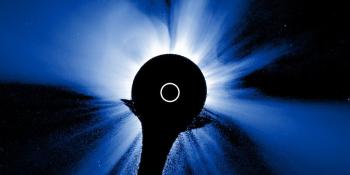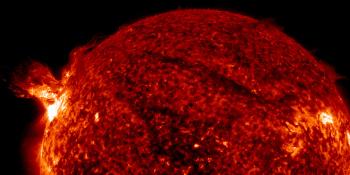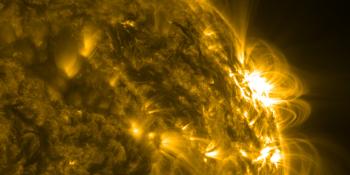Het archief bekijken van zondag 17 maart 2002
Activiteitenrapport
Bij elke genoemde zonnevlam in dit rapport werd een schaalfactor toegepast door het Space Weather Prediction Center (SWPC). Vanwege de SWPC-schaalfactor worden zonnevlammen 42% kleiner gerapporteerd dan voor de wetenschappelijke data. De schaalfactor werd verwijderd uit onze gearchiveerde zonnevlamdata om de werkelijke fysieke eenheden weer te geven.
Rapport van de zonne- en geofysische activiteit van 2002 Mar 17 2200 UTCOpgemaakt door de NOAA © SWPC en verwerkt door Poollicht.be
USAF/NOAA rapport van de zonneactiviteit en geofysische activiteit
SDF Nummer 076 gepubliceerd omstreeks 2200Z op 17 Mar 2002IA. Analyse van de actieve zonneregio's en zonneactiviteit van 16-2100Z tot 17-2100Z Solar activity was moderate during the past 24 hours.
Region 9871 (S18E20) produced today's biggest event, an impulsive
M4/Sf at 1931 UTC. The region appears to be growing slowly. An
additional M-class event occurred: an M1 at 1019 UTC for which there
was no optical report. Region 9866 (S09W33) is decaying gradually,
but is still the largest region on the disk. Retrospective analysis
of the CME that occurred around 15/2310 UTC shows a full halo event
with an estimated plane-of-sky speed somewhere in the 750-850 km/s
range. New Region 9873 (S17W09) emerged near the middle of the solar
disk during the past 24 hours.
IB. Voorspelling zonneactiviteit
Solar activity is expected to be
moderate during the next three days, with Regions 9866 and 9871
being the most likely sources.
IIA. Samenvatting geofysische activiteit 16-2100Z tot 17-2100Z
The geomagnetic field was quiet during the past 24 hours. The greater
than 10 MeV protons began to rise at the very end of the UT day
yesterday and crossed event threshold at 17/0820 UTC. The fluxes
reached a maximum of 13 PFU at 17/0850 UTC. The fluxes dropped below
threshold at 17/1230 UTC, but have been fluctuating and have been on
the increase since around 1500 UTC. It seems probable that the
current slow climb is related to the approach of an interplanetary
shock.
IIB. Voorspelling geofysische activiteit
The geomagnetic field is
expected to reach active to minor storm levels tomorrow in response
to the halo CME event of 15/2310 UTC. A decrease to active is
expected on the second day and a further decline to unsettled is
expected by the third day. The current trend of the 10 MeV protons
and the likely arrival of a shock in the next 12 hours all suggest
that the proton fluxes should once again cross threshold.
III. Kans zonnevlammen van 18 Mar tot 20 Mar
| Klasse M | 50% | 50% | 50% |
| Klasse X | 05% | 05% | 05% |
| Proton | 50% | 05% | 05% |
| PCAF | yellow | ||
IV. Penticton 10.7 cm Flux
Geobserveerd 17 Mar 184 Voorspeld 18 Mar-20 Mar 190/195/190 90 dagen gemiddelde 17 Mar 215
V. Geomagnetische A index
Geobserveerd Afr/Ap 16 Mar 005/005 Geraamd Afr/Ap 17 Mar 005/005 Voorspeld Afr/Ap 18 Mar-20 Mar 030/030-020/020-010/010
VI. Kansen op geomagnetische activiteit van 18 Mar tot 20 Mar
| A. Gemiddelde breedtegraad | |||
|---|---|---|---|
| Actief | 20% | 25% | 25% |
| Kleine storm | 25% | 20% | 15% |
| Zware-ernstige stormcondities | 20% | 15% | 05% |
| B. Hoge breedtegraad | |||
|---|---|---|---|
| Actief | 20% | 25% | 30% |
| Kleine storm | 25% | 20% | 15% |
| Zware-ernstige stormcondities | 25% | 20% | 10% |
Alle tijden in UTC
<< Keer terug naar de dagelijkse overview pagina
Laatste nieuws
Laatste forumberichten
Noorderlicht kans mogelijkheid 6-14 dec 2025 14STEVE, een nog onbegrepen fenomeen 1Noorderlichtkans 11-12 november 2025 21Noorderlicht kans 18 juni 2025 3Noorderlicht 2 juni 2025 3
Meer forumberichtenSteun Poollicht.be!
Veel mensen komen naar Poollicht.be om de zonneactiviteit te volgen of om het poollicht te zien, maar met meer bezoekers komen er hogere kosten bij om de servers online te houden. Als je Poollicht.be leuk vindt en het project wilt steunen, kun je kiezen voor een abonnement op een advertentievrije website of een donatie overwegen. Met jouw hulp kunnen we Poollicht. be online houden!
Ruimteweer feitjes
| Laatste X-klasse uitbarsting | 08/12/2025 | X1.1 |
| Laatste M-klasse uitbarsting | 21/12/2025 | M1.3 |
| Laatste geomagnetische storm | 22/12/2025 | Kp5 (G1) |
| Zonnevlekkenloze dagen | |
|---|---|
| Laatste zonnevlekkenloze dag | 08/06/2022 |
| Maandelijks gemiddeld zonnevlekkengetal | |
|---|---|
| november 2025 | 91.8 -22.8 |
| december 2025 | 115.2 +23.4 |
| Afgelopen 30 dagen | 109.4 +23 |





